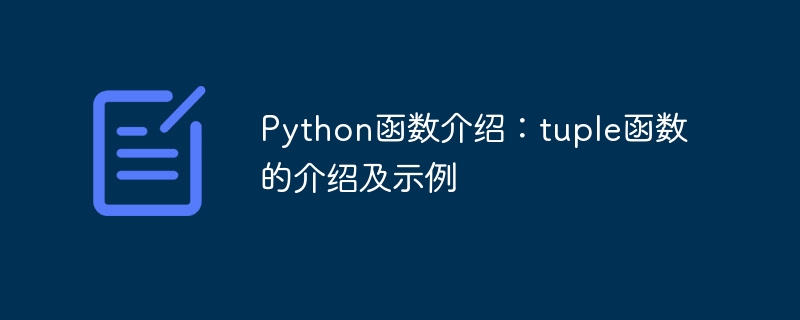

Introduction to Python functions: introduction and examples of tuple function
In the Python programming language, tuple (tuple) is an immutable ordered data type. It is similar to a list, but unlike a list, a tuple cannot be modified once it is created. Tuples can contain different types of data and are represented by parentheses (). The tuple function is one of Python's built-in functions, used to convert a sequence (list, string, or other iterable object) into a tuple. This article will introduce the usage of tuple function and provide corresponding sample code.
The usage of tuple function is as follows:
tuple(iterable)
where iterable is any iterable object, such as list, string, etc. The function returns a tuple containing all elements in the iterable.
Here are a few examples to help us better understand the usage of the tuple function.
Example 1:
Suppose we have a list that stores the names of some employees:
names = ['Alice', 'Bob', 'Charlie', 'David' ]
We can use the tuple function to convert this list into a tuple:
tuple_names = tuple(names)
print(tuple_names)
Run the above code, the output will be as follows:
('Alice', 'Bob', 'Charlie', 'David')
Example 2:
We can also use the tuple function to convert a string into a tuple. Consider the following example:
string = 'Hello, World!'
We can convert a string into a tuple by passing it to the tuple function:
tuple_string = tuple(string )
print(tuple_string)
Run the above code, the output result is as follows:
('H', 'e', 'l', 'l', 'o', ',', ' ', 'W', 'o', 'r', 'l', 'd', '!')
Example 3:
Not only can lists and strings be converted to tuples, but also Convert other iterable objects to tuples. Let’s look at an example:
range_obj = range(1, 6)
We can convert the range object into a tuple:
tuple_range = tuple(range_obj)
print( tuple_range)
Run the above code, the output result is as follows:
(1, 2, 3, 4, 5)
Summary:
Through the tuple function, we can easily combine a list, Convert a string or other iterable object to a tuple. Tuples are more suitable than lists in some scenarios because they are immutable, which means that their elements cannot be modified. The tuple function is one of the powerful functions built into Python and is very practical when processing data.
The above is the introduction and examples of the tuple function. I hope the content of this article will be helpful to everyone's understanding of the tuple function and its usage.
The above is the detailed content of Introduction to Python functions: introduction and examples of tuple functions. For more information, please follow other related articles on the PHP Chinese website!




